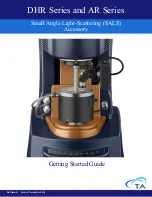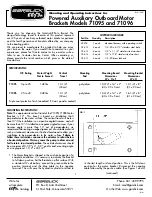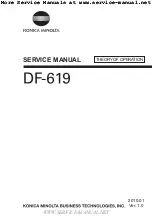
European Safety Systems Ltd.
Impress House, Mansell Road, Acton, London W3 7QH
www.e2s.com Tel: +44 (0)208 743 8880
Document D154-00-001-IS Issue 6 12-09-2022
Sheet 2 of 2
6)
Earthing
The unit has an internal earth terminal.
It is recommended that a cable crimp lug is used
on the earth wires.
The internal earth wire is placed under a earth
clamp which will stop the cable twisting. This is
secured by an M4 screw and spring washer.
Internal Earth
Ex e terminal block
terminal
Note: Depending on options chosen an 8-Way DIN
Rail or 6-Way terminal block may be selected.
7)
Cable connections
There are 3 off cable entries for M20x1.5 Ex e
approved cable glands or stopping plugs with a
minimum ingress protection of IP66.
The unit can be wired in a number of different ways
depending whether normally open or normally
closed contacts are required. See wiring schematic
D154-06-001 for wiring options.
When wiring to Increased Safety terminal
enclosures, you are only permitted to connect one
wire into each way on the terminal block, unless a
pair of wires are crimped into a suitable ferrule. For
the six-way terminal block wire sizes allowable are
0.5mm²
to
4.0mm². For the 8-way DIN rail wire
sizes allowable are 0.5mm² to 2.5mm²
Leads connected to the terminals shall be insulated
for the appropriate voltage and this insulation shall
extend to within 1mm of the metal of the terminal
throat. They shall only be installed and wired with
cable in an ambient temperature of -10°C to +80°C
All terminal screws, used or unused, shall be
tightened down to between 0.5 Nm and 0.7 Nm.
8)
Testing unit operation
The break glass unit can be tested without the
need to break/replace the frangible glass element.
A test key is used to mechanically drop the glass
down activating the switch.
The test key is inserted in the test cam and rotated
clockwise by an angle of 60º the glass element will
visibly drop down in the viewable window.
The call point switch will now change over its
contacts to operate the alarm.
Once testing is complete the unit needs to be
reset, the test key is rotated back anticlockwise by
an angle of 60º back to its original position. The
glass element should now raise up so it is level
again in the viewable window.
1.
2. 3.
Insert test Hold in Rotate back
Key rotate position anticlockwise
clockwise during to reset
60º test
9)
Replacement of glass element
If the break glass unit has been operated the
broken glass element can be quickly replaced.
The break glass cover plate is removed by
unscrewing the 4 off M4 cap head screws attaching
it.
Once the cover is removed the broken glass will be
free to be removed, clean out any other fragments
of glass carefully.
To fit the new glass element rotate the top cam
clockwise by an angle of 50º (use a 6mm Allen
key) this will than allow the glass to fit back into the
pocket it sits in, resting on the pivot point and test
cam, release the top cam to rest on the top of the
glass element.
Pivot point Test Cam Top Cam (rotate)
Replace the cover plate and tighten the 4 off M4
cap head screws.
Ensure the glass element is free to move under the
cover plate. This can be done by running through
the units test operation. See section 8 of this
instruction manual.
10) SIL 2 Reliability Data
Reliability and Functional safety IEC/EN61508
which has been assessed and is considered
suitable for use in low demand safety function:
• Random Hardware Failures and Systematic
Failures (route 2H)
• As an unvoted item (i.e. hardware fault tolerance
of 0) at SIL 2
The product was assessed against failure modes:
• Failure to close a contact when the call point is
struck with specified force
• Failure to open a contact when the call point is
struck with specified force
• Spurious output despite no input
Integrity in respect of failure to close
SIL 2
Total Failure rate
0.133 pmh
“hazardous” failure rate (revealed)
0 pmh
“hazardous” failure rate (unrevealed)
0.1 pmh
“safe” failure rate (revealed)
0.033 pmh
“safe” failure rate (unrevealed)
0
Diagnostic Coverage
99%
System type
A
Hardware Fault Tolerance
0
Safe Failure Fraction
>99%
PFD (hazardous failure)
1.25 x 10
-3
Proof Test Interval
Up to 1 year
























